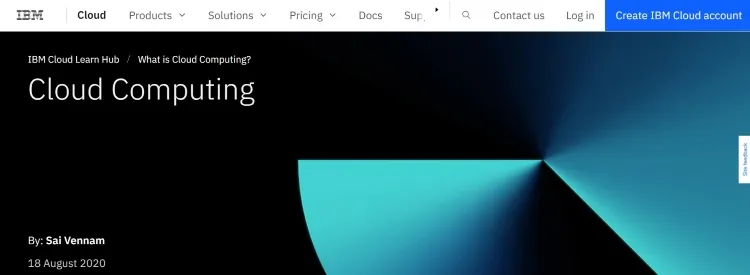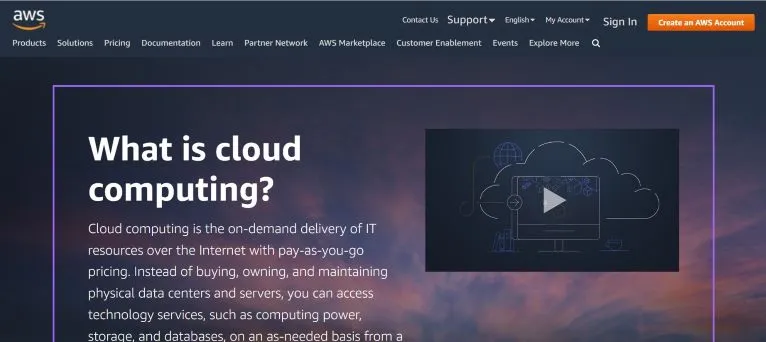Cloud solutions have already been covered in two Journal articles: “How to move an application to a cloud?” and “Serverless business.”
If you have ever wondered what Cloud Computing is, the name AWS Cloud Computing probably rings a bell.
If you haven’t pondered Cloud Computing but want to know what this concept is all about, be sure to read this article.
Why?
Because we deal with Cloud Computing almost all the time. Even if we don’t know it.
And you need to know that such services as video and audio streaming, online games, or access to storage space are based on cloud solutions.
However, Cloud Computing is not a service for the biggest market players only.
The customers of Amazon Web Services (AWS), Microsoft Azure, Google Cloud, Alibaba Cloud, IBM Cloud, Oracle, and Salesforce also include small and medium-sized enterprises.
From the wide range of services, companies in the SME sector can select dedicated solutions tailored to their needs, operation scale, and financial capacity.
Cloud Computing provides access to software, applications, services, technology, and resources characterized by high technological advancement, efficiency, and security.
OK, but what are other benefits of Cloud Computing for an organization? What type of computing services does Cloud Computing offer?
What are the costs of using Cloud Computing for an organization? Is Cloud Computing secure?
These are the questions that we will try to address in this article.
In a moment, it will become clear what Cloud Computing is. Without further ado, enjoy reading!
Cloud Computing - what is it?
Cloud Computing is about providing remote computing services (including storage, servers, databases, networks, software, and AI solutions).

To answer the question: What is Cloud Computing? It must be said that it is also the offer of highly advanced and innovative technologies and flexible resources enabling, among others, digital business scalability.
In his article “Cloud Computing – charakterystyka i obszary zastosowań w przedsiębiorstwach” (Cloud Computing: characteristics and areas of application in business), Damian Dziembek points to another feature of Cloud Computing.
According to this author, Cloud Computing is both a set of information and communication technologies and a model of data processing in the form of services.
He aptly adds that Cloud Computing has completely redefined the way IT solutions are delivered by providers and the way they are purchased, used, and financed by customers.
In addition, Cloud Computing is mainly based on the following:
- Virtualization that enables companies to use hardware resources, services, and software more efficiently
- Grid Computing that provides very high computing power, security, operational stability, and relatively high reliability
- Utility Computing expressed in, e.g., specific computing power offered on demand, the payment for which is calculated according to actual consumption
- Autonomic Computing which is a processing system capable of self-control without the need for human intervention
- Service-Oriented Architecture (SOA) that addresses actual user needs.
The Cloud Computing definitions most often emphasize the following features:
- The convenience of this model
- Speed of providing solutions, technologies, services, and tools
- Guarantee that scalability and reliability will be provided
- Much less need for relevant competencies and (hardware, technological and human) resources; the user is not required to have extensive and deep knowledge about the way the service is provided
- Attractive payment model: the payment is charged at the moment of actual use (the Pay-as-you-go model)
- High user-friendliness and variety of offered services
- Service measurability
- Dynamic flexibility: the range of services can be quickly adapted to the changing needs.
Cloud Computing also solves another problem.
Instead of investing in the purchase, maintenance, development, and servicing of servers, data centers, software, and technologies, an organization simply buys them on demand.
Purchasing computing power, storage, software access, or digital services in such a formula is much less expensive than their individual creation and development.
The purchase of a license is quite costly and limiting. And independent development of infrastructure and technology requires an investment that will only return after many years.
For many companies, state-of-the-art technological solutions are simply unavailable in terms of budget, time, organization, and market (e.g., there are not enough highly trained specialists in a given market).
Unfortunately, you must also be aware that technological development is very dynamic.
To meet these requirements and keep up with the changes, organizations must be ready for them in terms of the above issues.
The advantage of Cloud Computing is also the lack of location restrictions. Providers offer services to customers from all over the world.
Cloud Computing is most commonly used for:
- Data backup
- Data recovery
- Writing, debugging, running, and testing cloud-native applications
- Ensuring application security
- Large data set analysis
- Providing optimum scalability of services, content, and businesses
- Providing desired performance
- Creating and running configurable virtual machines
- Creating, implementing, and scaling Artificial Intelligence (AI) models
- Application migration.
Benefits of Cloud Computing
With extensive data centers and technologies, Cloud Computing can provide customers with access to hardware, infrastructure, software, and services.
Frankly, the difference between satisfying hardware and technological needs on one’s own and the results obtained through cloud platforms is enormous.
First of all, individual development requires the following:
- A team of several, and in many cases more than ten, people (an internal IT department dedicated to the development and maintenance of the IT infrastructure)
- Regular costly hardware upgrades
- A budget that also supports the costs of electricity, renting and maintaining appropriate conditions in server rooms, that guarantee security, continuous hardware operation, and its proper use.
The attractiveness of cloud solutions is self-evident precisely because of the ineffectiveness, impracticality, expansiveness, and riskiness of individual activities.
Moreover, organizations using Cloud Computing do not have to concern themselves with the following:
- The necessary level of security
- Desired scalability
- Necessary regular maintenance
- Necessary infrastructure upgrading
- Logistics, organization, and reliability
- Infrastructure operational continuity which can be easily lost due to emergencies (e.g., contingencies).
What makes Cloud Computing attractive and unquestionably advantageous are the costs. And the differences here are significant.
Another great advantage of cloud solutions is that the monthly, quarterly, or annual costs are very easy to calculate or estimate using, e.g., a price calculator (e.g., AWS Pricing Calculator).
Quite often, the costs of the offered services, tools and machines decrease with the increase in demand (e.g., the Pay less by using more formula available from AWS).
An important point, which is an obvious benefit in terms of finances, time, and organization, is that the provider of cloud services bears the costs of repairs, maintenance, and development.
Cloud Computing releases the user from the need to think about reliability. In the event of a failure, restoring application operation and its backup recovery is simpler, faster, and less expensive. And most importantly, such events are not frequent.
With the cloud, ensuring the continuity of user access to applications is much cheaper and easier.
The frequently highlighted features of Cloud Computing are agility and flexibility, which in practice mean:
- Direct access to a wide range of technologies
- Possibility of using technological innovation
- Possibility of building, testing, and developing any type of digital products
- Possibility of experimenting and searching for the most effective solutions
- Possibility of testing new ideas
- Faster digital transformation of an organization
- No need for resources allocation in advance
- Possibility of resource scaling
- Access to global markets, e.g., with global infrastructure, AWS enables application deployment across multiple physical locations
- Increased productivity: many users can work with the same data simultaneously.
The advantages of Cloud Computing not to be missed are also Continuous Integration (CI) and Continuous Delivery (CD).
Continuous Integration and Continuous Delivery above all:
- Increase work efficiency
- Reduce the digital product time to market
- Automate the processes of code building, testing, and implementation.
Security of Cloud Computing
Cloud Computing implementation is an investment in broadly understood security: legal, technological, infrastructural, and cybercrime related.
As a matter of fact, and it is not an exaggeration, Cloud Computing equals data security.
Cloud Computing definitely deals with threats better and is much better at preventing and handling the consequences of attacks. Above all, the leading cloud platform providers are constantly developing security systems with considerable investment.
New technologies, solutions, and tools are a permanent feature of cloud platform reputation-building in terms of cybersecurity.
The most important areas of Cloud Computing security include the following:
- Cloud Security Gateways that enable data encryption, prevent data loss, and are aimed at malware and cloud access anomaly detection
- Centralized Cloud Security Management that controls security configuration and file configuration integrity
- Hypervisor Security: a toolkit for activity monitoring between the guest operating system and the hypervisor.
Additionally, cloud security is provided by:
- Data encryption during rest, transfer, and use
- User identity and access management
- Security and compatibility monitoring.
Cloud Computing service models
Cloud Computing is available in several deployment models.
The diversification of models is justified because it enables more flexible and accurate offer addressing.
Public Cloud
In this variant, a cloud platform supports multiple companies using the same infrastructure. Each organization’s privacy is ensured, and each organization is separated from the others.
As an owner, the provider is fully responsible for data centers, hardware, and infrastructure.
The public cloud service provider takes care of each organization’s maintenance, security, flexibility, and scalability.

In other words, a public cloud is built of resources the end user does not own.
Google Gmail is an example of a public cloud.
Private Cloud
Private clouds are also called corporate, internal, or local clouds.
Clouds of this type are built of resources physically owned or leased by the user.
Privacy is implemented through restricted access: the cloud services can only be used by users from a given organization.
A dedicated IT team is responsible for the infrastructure’s maintenance, development, and security.
Private clouds are usually much more expensive and problematic than public platforms.
Hybrid Cloud
The main purpose of this model is to combine the best of both worlds. Organizations usually use hybrid clouds to separate different needs.
Private clouds are used for critical or sensitive functions, while public clouds are usually employed when high computing power is required.
The data flow in hybrid clouds is automatic. It provides excellent flexibility, security, and compatibility.
Multicloud model
Driven by different needs and goals, many organizations opt for cloud platforms from different providers.
Using diverse offers from multiple providers enables you to flexibly configure and adapt functions, tools, solutions, and technologies.
For example, the need to analyze large volumes of data can be satisfied by provider X and backup by provider Y.
SaaS (Software as a Service) Cloud Computing
Cloud Computing is very often equated with the most popular type of cloud data processing, i.e., Software as a Service.
SaaS offers users on-demand a ready-to-use application instead of a software installation file (downloaded from the Internet or provided on various media).
It is available online and does not require installation or purchasing a special dedicated license.
The application is used by multiple users simultaneously, and the cloud service provider is fully responsible for its proper operation.
As distinguished by Damian Dziembek, quoted above, the following are most frequently offered in this formula:
- Utility applications
- Industry-specific applications
- Applications supporting communication
- Applications supporting the document workflow
- Applications supporting information and knowledge management
- Applications supporting cooperation.
IaaS (Infrastructure as a Service)
Infrastructure as a Service allows the users to “rent” physical or virtual servers, memory, and storage resources or network hardware.
IaaS is valued mainly by organizations that want to create, test and develop applications and control all the components related to these processes.
In this model, the cloud platform owner is also responsible for the proper functioning and maintenance of hardware and network resources.
Amazon Elastic Compute Cloud (EC2) is an example of Infrastructure as a Service.
PaaS (Platform as a Service)
If you are familiar with such development platforms as Microsoft Azure or Google App Engine, then you know the following Cloud Computing variant, i.e., Platform as a Service.
PaaS provides users with structural components used for software development.
The offered stack includes developer tools, libraries, servers, development environments, and application components.
Platform as a Service allows the users to quite effectively solve the most critical backend issues: server infrastructure, security, data integration, and computing power consumption.
PaaS primarily facilitates fast application creation by developers without the need to configure the basic server infrastructure, storage, network, and databases needed for application development or management.
Cloud Computing: costs
When writing about the benefits of Cloud Computing, we mentioned that the costs of using public cloud platforms are much lower.

Both in terms of immediate costs and the costs related to its development and maintenance.
Cloud Computing and cloud platforms, above all, eliminate the following:
- Hardware purchase expenses
- Software purchase expenses
- IT specialist employment expenses
- Local data center operation expenses
- Maintenance and data recovery expenses.
The cost differences are a very individual matter. Still, it is estimated that the organizations that opt for Cloud Computing can save as much as a dozen or so percent.
Technology Advice, in the article “4 Ways Cloud Computing Can Save Your Company Money,” specifies that companies can save an average of 15% on their costs if they decide to support their operations with Cloud Computing.
According to the article “25 Must-Know Cloud Computing Statistics in 2022,” cost optimization is the primary reason for 47% of enterprises’ cloud migration.
Cloud Computing: examples
If you enter phrases such as “Cloud Computing examples,” “types of cloud computing,” or “IT resources” into a search engine, you will get many results.

When we use the services of companies such as Google, Facebook, or Dropbox, we are actually using cloud solutions that provide IT infrastructure, virtual machines, operating systems, and data storage, so we don’t have to worry about data loss.
Marketers who use, e.g., the offer of Hubspot or Adobe Marketing Cloud in their daily work are also, in fact, using cloud services.
Cloud solutions are particularly frequently used in the following applications:
- Educational
- Health care
- Government
- Communication
- Supporting business processes
- Supporting public services.
What is Cloud Computing? Summary
- Cloud Computing is about providing remote computing services.
- Cloud Computing is the offer of highly advanced, innovative technologies and flexible resources enabling, among others, digital business scalability.
- Cloud Computing has completely redefined how IT solutions are delivered by the providers and purchased, used, and financed by the customers.
- For many companies, state-of-the-art technological solutions are unavailable in terms of budget, time, organization, and market.
- The attractiveness of cloud solutions is self-evident precisely because of the ineffectiveness, impracticality, expansiveness, and riskiness of individual activities.
- Cloud Computing implementation is an investment in broadly understood security: legal, technological, infrastructural, and related to cybercrime.
- New technologies, solutions, and tools have become the permanent component of Cloud Computing reputation-building in terms of security.
- Cloud Computing is offered in several deployment models.
- Cloud Computing implementation and use mean real savings.
- The organizations that opt for Computing Cloud services can save as much as a dozen or so percent.








